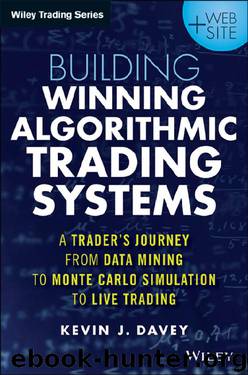Building Algorithmic Trading Systems: A Trader's Journey From Data Mining to Monte Carlo Simulation to Live Trading, + Website by Kevin J. Davey

Author:Kevin J. Davey [Kevin J. Davey]
Language: eng
Format: epub
Tags: Personal & Professional Development
Publisher: John Wiley & Sons
Published: 2014-07-20T21:00:00+00:00
Test Period: 5/1/2012 to 5/1/2012 Percentage of Random Cases with Net Profit Worse than Baseline Case (–$1,105)
Percentage of Random Cases with Maximum Intraday Drawdown Worse than Baseline Case (–$15,100)
Random entry, baseline exit 50%
64%
Baseline entry, random exit 1%
1%
Random entry, random exit 49%
72%
The results here are much clearer now. On average, the monkey systems are equal to or better than the baseline strategy. This indicates that any edge the strategy originally had is gone or is certainly on hiatus. Wise traders would stop trading this system near the beginning of May 2013. In this case, judging from the performance of the baseline strategy after May 1, 2013, that was a good decision.
Comparison of your strategy to randomly generated strategies can be useful, too. In the preceding example system, the analysis was able to show that the strategy as developed was significantly better than a random, monkey-throwing-darts system. That is nice to know, as it gives you confidence as you begin to trade.
Unfortunately, running this analysis when you develop the strategy tells you nothing about how well the strategy will work going forward. The strategy itself could be defective, leading to real-time losses. Or the characteristics of the market may have changed, and your strategy cannot adapt to it. In either case, periodically comparing the baseline strategy results to the random monkey results can help you decide whether the strategy is broken. As the earlier analysis shows, the random test can be an early warning detection method of sorts, and can suggest that you stop trading the strategy until performance becomes better than random. Thus, it can be a useful tool in deciding when to stop trading a strategy.
Download
This site does not store any files on its server. We only index and link to content provided by other sites. Please contact the content providers to delete copyright contents if any and email us, we'll remove relevant links or contents immediately.
| Analysis & Strategy | Bonds |
| Commodities | Derivatives |
| Futures | Introduction |
| Mutual Funds | Online Trading |
| Options | Portfolio Management |
| Real Estate | Stocks |
Rich Dad Poor Dad by Robert T. Kiyosaki(6401)
Pioneering Portfolio Management by David F. Swensen(6226)
How To Win Friends and Influence People by Dale Carnegie(4443)
The Money Culture by Michael Lewis(4076)
The Dhandho Investor by Mohnish Pabrai(3699)
The Wisdom of Finance by Mihir Desai(3651)
Liar's Poker by Michael Lewis(3368)
Fooled by Randomness: The Hidden Role of Chance in Life and in the Markets by Nassim Nicholas Taleb(3044)
The ONE Thing by Gary Keller(3007)
The Intelligent Investor by Benjamin Graham Jason Zweig(2995)
Mastering Bitcoin: Programming the Open Blockchain by Andreas M. Antonopoulos(2981)
How to Day Trade for a Living: Tools, Tactics, Money Management, Discipline and Trading Psychology by Andrew Aziz(2909)
Rich Dad Poor Dad: What The Rich Teach Their Kids About Money - That The Poor And Middle Class Do Not! by Robert T. Kiyosaki(2908)
Investing For Dummies by Eric Tyson(2894)
How to Win Friends and Influence People by Dale Carnegie(2863)
Market Wizards by Jack D. Schwager(2643)
Zero Hour by Harry S. Dent Jr. & Andrew Pancholi(2614)
How to Pay Zero Taxes, 2018 by Jeff A. Schnepper(2595)
The Psychology of Money by Morgan Housel(2593)
